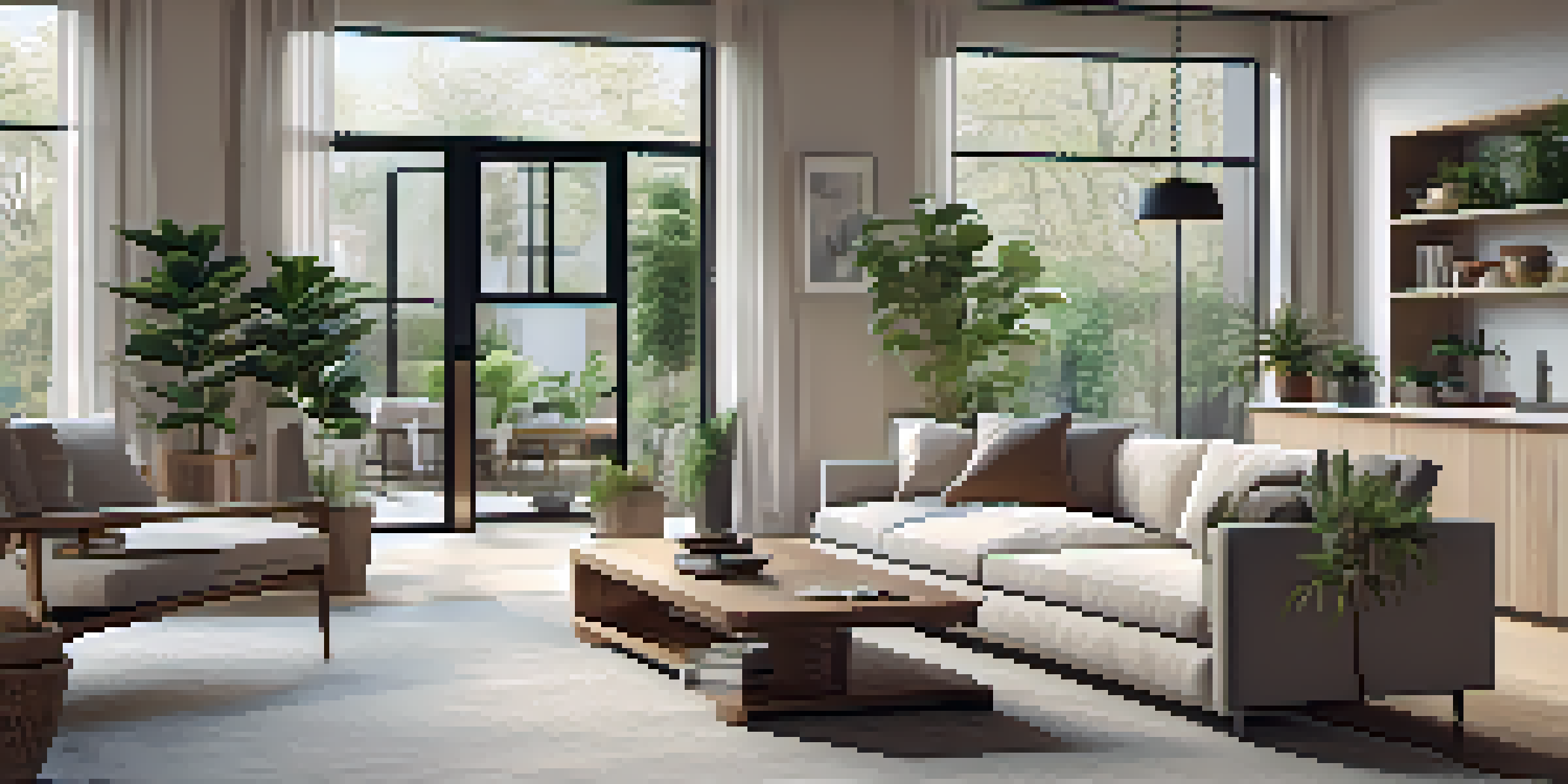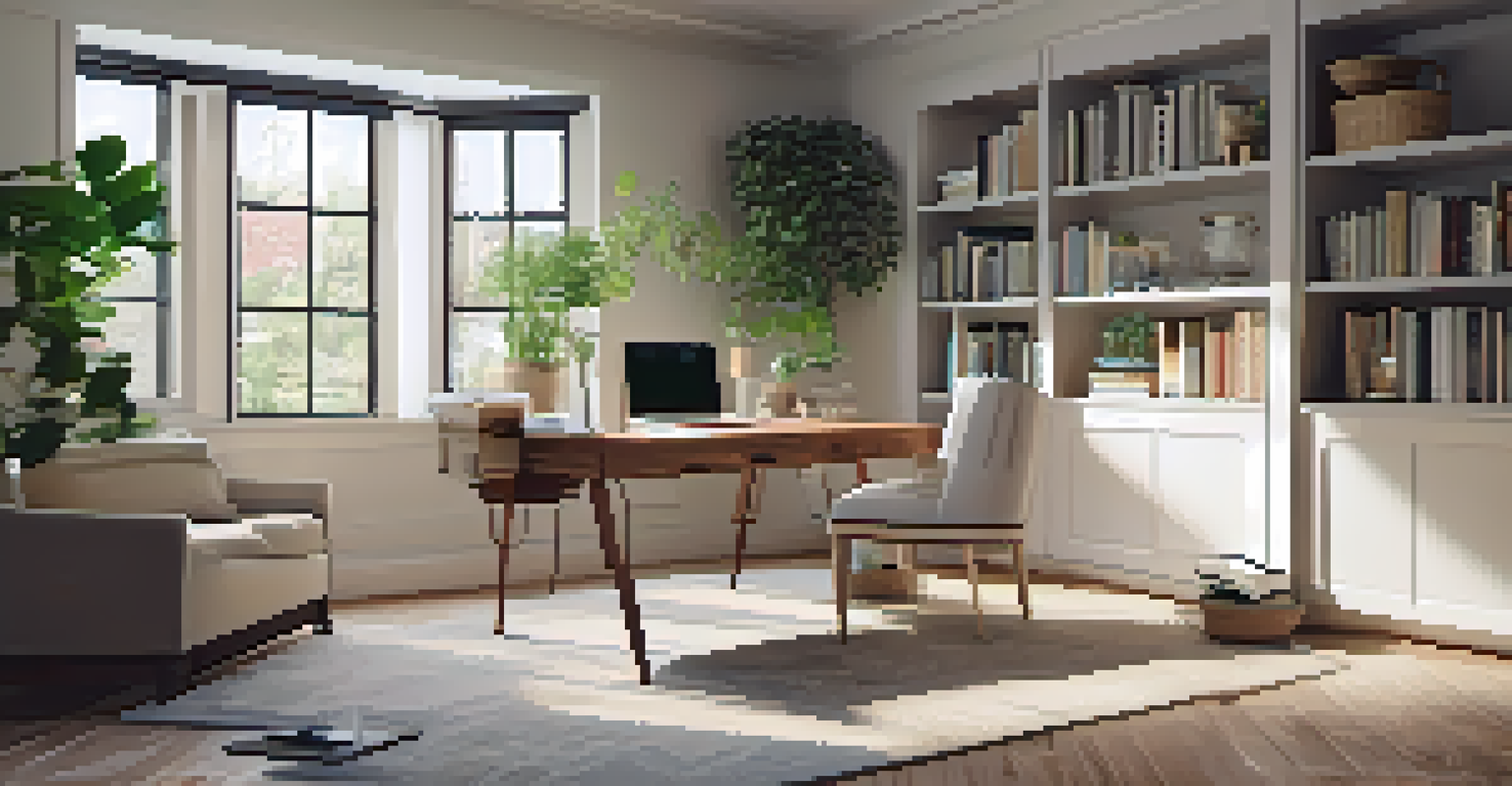The Evolution of Open Concept Living Spaces

The Origins of Open Concept Living Spaces
Open concept living spaces can trace their roots back to early 20th-century architecture, particularly the Arts and Crafts movement. This design philosophy emphasized functionality and the connection between spaces, paving the way for more integrated home layouts. Architects like Frank Lloyd Wright championed the idea of blending indoor and outdoor environments, which significantly influenced modern designs.
The home should be the treasure chest of living.
As homes evolved, the idea of separating rooms for specific purposes began to shift. Instead of isolated dining or living areas, homeowners started to appreciate the fluidity of open spaces that encouraged interaction and socializing. This evolution mirrored societal changes, as families sought more communal areas where they could gather and enjoy each other's company.
By the 1970s and 1980s, the concept of open living spaces gained significant traction in suburban homes. Builders and architects began to embrace the idea of removing walls to create expansive living areas, which not only maximized space but also catered to the desire for a more casual, relaxed lifestyle.
The Impact of Minimalism on Open Concepts
As minimalism emerged as a lifestyle choice, it greatly influenced open concept living spaces. The focus on simplicity and functionality led to a preference for fewer walls and clutter-free environments. This design philosophy emphasizes quality over quantity, encouraging homeowners to curate their spaces carefully.

Minimalist design often incorporates natural materials and neutral color palettes, which help to create a calm and cohesive atmosphere. In open concept spaces, this can result in a seamless flow from one area to another, making the home feel more spacious and inviting. Furnishings also tend to be multifunctional, further enhancing the sense of openness.
Open Concepts Embrace Community Living
Open concept living spaces promote interaction and socializing, reflecting a shift towards more communal home environments.
The influence of minimalism has not only shaped aesthetics but also improved how we interact within our homes. With fewer barriers, families can engage more naturally, fostering a sense of community and togetherness that resonates in today's fast-paced world.
Technological Advancements and Open Living
The rise of smart home technology has undoubtedly impacted open concept living spaces. Home automation systems allow for seamless integration of lighting, sound, and climate control, enhancing the overall living experience. This tech-savvy approach aligns perfectly with the open concept philosophy, simplifying how we interact with our environment.
Simplicity is the ultimate sophistication.
For instance, imagine hosting a dinner party where you can control the ambiance with a single tap on your smartphone. You can adjust the lighting, play music, and even control the thermostat without leaving the comfort of your open living area. These advancements have made homes more adaptable to various functions, from entertaining guests to enjoying quiet family evenings.
Moreover, technology has facilitated the incorporation of sustainable practices within open concept designs. Energy-efficient appliances and smart systems can help homeowners reduce their carbon footprint while enjoying the benefits of an expansive, interconnected space.
Cultural Influences on Open Concept Design
Cultural influences play a significant role in shaping open concept living spaces. Different cultures have varying approaches to home design, often reflecting their values and lifestyles. For example, Mediterranean designs typically incorporate open layouts that emphasize outdoor living, while Nordic styles favor simplicity and light-filled spaces.
In many Asian cultures, the concept of 'feng shui' has influenced how spaces are arranged to promote harmony and balance. This has led to designs that prioritize open areas for natural light and airflow, which are essential for creating a peaceful living environment. As globalization continues to blend cultural elements, we see more diverse influences in modern open concept homes.
Sustainability Shapes Modern Designs
The integration of eco-friendly materials and energy-efficient features is becoming essential in open concept layouts.
Homeowners today often draw inspiration from various cultures, resulting in personalized spaces that reflect their unique tastes. This fusion of styles not only makes homes more inviting but also enhances the sense of belonging and connection among family members.
The Role of Sustainability in Open Living Spaces
Sustainability has become a critical factor in the evolution of open concept living spaces. As awareness of environmental issues grows, homeowners are increasingly seeking eco-friendly materials and designs that reduce their carbon footprint. Open concept layouts lend themselves well to sustainable practices, as they often maximize natural light and ventilation.
For example, large windows and sliding doors can connect indoor spaces to outdoor environments, reducing reliance on artificial lighting and climate control. This not only benefits the environment but also enhances the overall living experience by creating a more inviting atmosphere.
Moreover, using reclaimed materials and energy-efficient appliances in open concept designs promotes a sustainable lifestyle. As homeowners prioritize eco-conscious choices, the integration of sustainability into open living spaces becomes a defining characteristic of modern design.
Challenges of Open Concept Living Spaces
While open concept living spaces offer numerous benefits, they come with their own set of challenges. One common issue is noise; with fewer walls to absorb sound, conversations in one area can easily disrupt activities in another. This can be particularly problematic for families with diverse schedules and needs.
Additionally, maintaining a sense of privacy can be difficult in open spaces. Without designated rooms, individuals may struggle to find quiet areas for work or relaxation. Homeowners must carefully consider their layout and design choices to create a balance between openness and personal space.
Technology Enhances Living Experiences
Smart home technology seamlessly integrates with open spaces, simplifying the management of lighting, sound, and climate.
Lastly, open concept designs can sometimes lead to visual clutter. With everything in view, it becomes essential to be intentional about decor and organization. Fortunately, creative storage solutions and thoughtful design elements can help mitigate these challenges, allowing homeowners to enjoy the benefits of open living.
The Future of Open Concept Living Spaces
As we look to the future, open concept living spaces are likely to continue evolving in response to changing lifestyles and preferences. The rise of remote work has already prompted a shift towards more adaptable home designs, with homeowners seeking multifunctional spaces that can accommodate both work and leisure.
Incorporating dedicated zones within open layouts may become a popular trend, allowing for privacy without sacrificing the overall aesthetic. This hybrid approach can provide the best of both worlds, catering to diverse needs while maintaining the inviting atmosphere that open concepts are known for.

Ultimately, the future of open concept living will be shaped by a combination of innovation, sustainability, and personal expression. As homeowners continue to seek spaces that reflect their values and lifestyles, we can expect to see exciting developments in how we design and inhabit our homes.